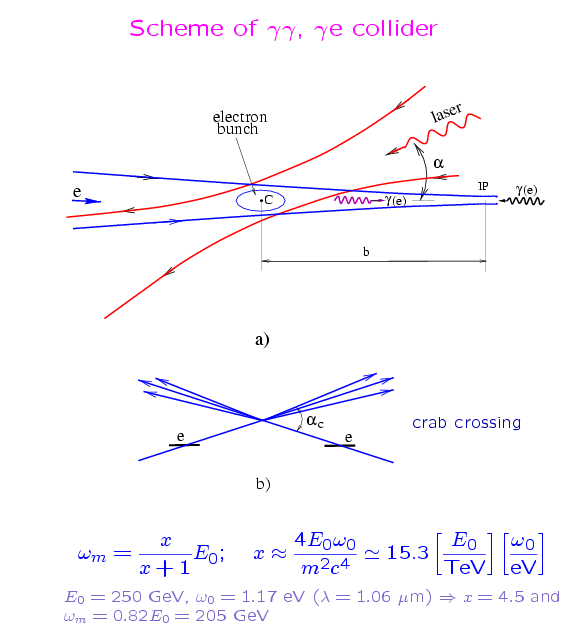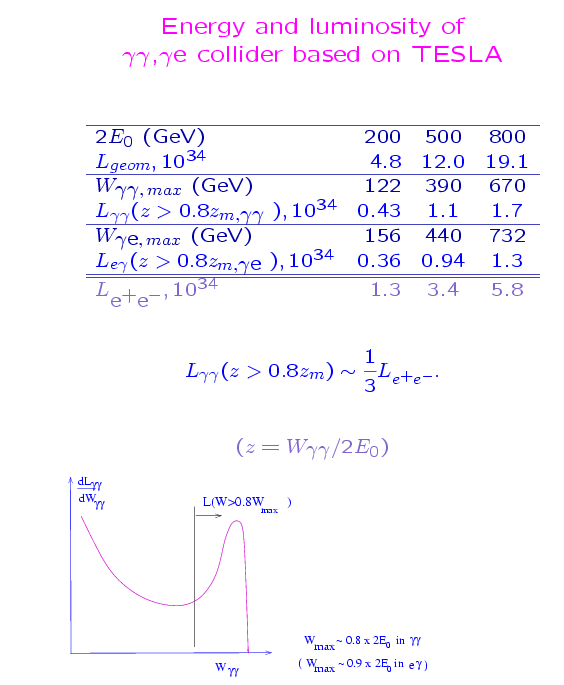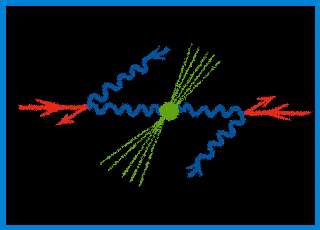American activities on photon colliders (second WWWpage)
Photon Collider Working
Group
WG activity (after
TESLA TDR)
Workshop and miniworkshops
-
First Workshop (of Extended ECFA-DESY study), Krakow,
Poland, 14-18 September, 2001
- Gamma-gamma
mini-workshop, Zeuthen, 13 Dec 2001
- Gamma-gamma physics meeting, CERN, 17
Dec 2001 (program)
(transperancies)
- Second
ECFA-DESY Workshop of Extended ECFA/DESY study, Saint
Malo, France, 12-15 April, 2002
- International
Workshop on Linear Colliders August 26-30, 2002 Jeju
Island, Korea (Session I)
-
Third ECFA-DESY Workshop, Prague, Czech Repulic, 15-18
November 2002
-
Forth ECFA-DESY Workshop, Amsterdam, Netherlands, 1-4
April 2003
-
First ECFA Workshop, Montpellier, France, 13-16 November
2003
(22.10.2001) Realistic luminosity
distributions at TESLA Photon Colliders. User's guide,
comments, data
Introduction
Principles of Photon Colliders
The basic scheme of the Photon Collider is shown below.
Two electron beams of energy E_0 after the final focus system
travel towards the interaction point (IP) and at a distance b
of about 1-5 mm from the IP collide with the focused laser
beam. After scattering, the photons have an energy close to
that of the initial electrons and follow their direction to
the interaction point (IP) (with small additional angular
spread of the order of mc^2/E_0 < 10^{-6} - 10^{-5}, where
they collide with a similar opposite high energy photons or
electrons. Using a laser with a flash energy of several Joules
one can ``convert'' almost all electrons to high energy
photons. The photon spot size at the IP will be almost equal
to that of the electrons at the IP and therefore the
luminosity of gamma-gamma, gamma-electron collisions will be
similar to the ``geometric'' luminosity of the basic e+e-
beams (positrons are not necessary for photon colliders). To
avoid background from the disrupted beams, a crab crossing
scheme is used, Fig. b with the crab crossing angle about 30
mrad. In this case final particles do not hit focusing
quadrupoles.

Properties of photon beams: spectrum, polarization, e+e-
pairs and nonlinear effects in conversion region

Cross sections for some processes in gamma-gamma, gamma-e
collisions


Luminosity spectra in gamma-gamma and gamma-electron
collisions at TESLA
Some slides:
1) V.Telnov. Photon
Coillider at TESLA (review of the TDR), talk at 2nd
Int.Workshop on High Energy Photon Colliders, FNAL, March
13-17, 2001
2) V.Telnov. The Interaction Region for gg, ge
collsions at linear colliders, talk at INSTR02 (Feb.2002),
NIM A 494 (2002) 35
Last updated by V.
Telnov on 22-July-2004





